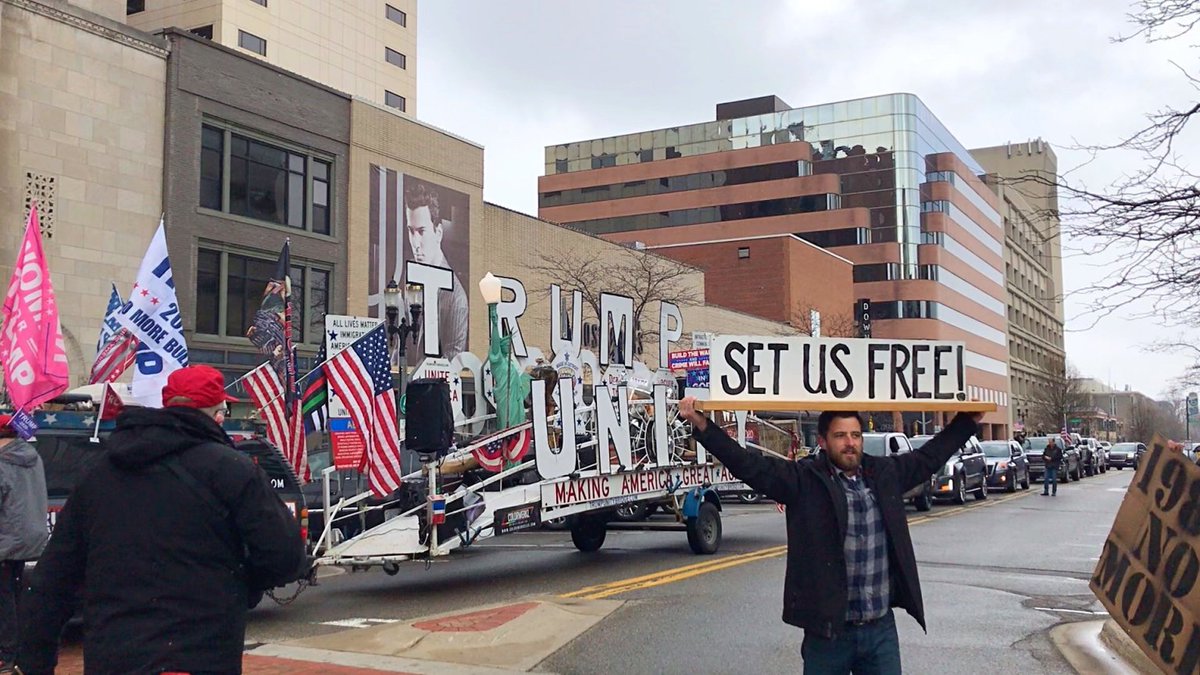THREAD: I& #39;ve read a lot of questions/criticism about reporters& #39; coverage of anti-gov& #39;t COVID-19 protests. I think the reporting thus far is defensible, but that newsrooms are currently at a crossroads.
Let me put on my best @jayrosen_nyu hat and try to explain it...
Let me put on my best @jayrosen_nyu hat and try to explain it...
^^^ photo by @AnnaLizNichols for @MichiganAdvance, one of my outlet& #39;s great sister pubs for @statesnewsroom.
I think there are many explanations for the protest coverage to this point over the past week or so:
I think there are many explanations for the protest coverage to this point over the past week or so:
1. After the rush of reports about major shutdowns + event cancellations, things have slowed in terms of fewer bombshells to report. Yes, there are still loads of important COVID-19 stories to cover, but these protests come amid a sort of lull of daily updates/reporting routines
2. It& #39;s geographic opportunity, for reporters/attention-seekers alike: the protests are being held at centers of gov& #39;t where reporters are headed anyway. In Ohio, journalists are hitting 2 birds w/1 stone by taking pics on their way in and out of statehouse press conferences.
3. There is a novelty to protests following a month-plus of uniformly glowing public response to the state gov& #39;t (here in Ohio, at least). A poll in March found 80% of Ohioans approve of @GovMikeDeWine& #39;s handling of the crisis. Yet *these* people are mad https://ohiocapitaljournal.com/2020/03/30/poll-ohio-voters-support-dewines-covid-19-response-are-split-on-trump/">https://ohiocapitaljournal.com/2020/03/3...
4. There& #39;s always the unavoidable truth that reporters, even the best-intentioned ones, are drawn to controversy. It& #39;s human nature to overestimate the impact of loud voices/big guns even if they are still very much an extremist minority. https://twitter.com/DC_DeWitt/status/1250816632785719296">https://twitter.com/DC_DeWitt...
So that explains the initial coverage, but why the *continued* coverage?
Well, I think the attention has shifted somewhat from noting the existence of these protests to now exposing the varied nature of their fringe elements: https://www.michiganadvance.com/2020/04/17/susan-j-demas-dont-whitewash-the-gops-extremism-on-full-display-during-whitmer-protest/">https://www.michiganadvance.com/2020/04/1...
Well, I think the attention has shifted somewhat from noting the existence of these protests to now exposing the varied nature of their fringe elements: https://www.michiganadvance.com/2020/04/17/susan-j-demas-dont-whitewash-the-gops-extremism-on-full-display-during-whitmer-protest/">https://www.michiganadvance.com/2020/04/1...
Packing away the reporters notebooks after 1 protest might give illusion that the discontent is only COVID-related. But we& #39;ve seen MAGA, anti-abortion/gun rights crowds and anti-Semites at these gatherings. I think there& #39;s value in exposing this stuff: https://twitter.com/laurahancock/status/1251590879598559237">https://twitter.com/laurahanc...
. @jwgop & others have fair beefs about the extent of coverage.
However: I don& #39;t think it has come at the expense of other reporting priorities. By & large, journalists across the U.S. have covered the virus responsibly/extensively in their communities. https://twitter.com/jwgop/status/1252212386846724097">https://twitter.com/jwgop/sta...
However: I don& #39;t think it has come at the expense of other reporting priorities. By & large, journalists across the U.S. have covered the virus responsibly/extensively in their communities. https://twitter.com/jwgop/status/1252212386846724097">https://twitter.com/jwgop/sta...
If you don& #39;t believe me, see my thread where I highlighted 88 outlets in all 88 Ohio counties, each covering the virus in many, many ways. Reporters may be drawn to controversy, but they& #39;re also drawn to important stories and quieter tales of human good: https://twitter.com/Tylerjoelb/status/1252005354860396544">https://twitter.com/Tylerjoel...
Quick aside: @MarionRenault did the same exercise in Minnesota. You could do this in every state in America. https://twitter.com/MarionRenault/status/1252020915291983873">https://twitter.com/MarionRen...
Now.
All that said, we are presently at a crossroads. The initial coverage is explainable, and the further coverage highlighting the protesters/their motives is also explainable.
Where we go from here, however -- now *that& #39;s* the rub.
All that said, we are presently at a crossroads. The initial coverage is explainable, and the further coverage highlighting the protesters/their motives is also explainable.
Where we go from here, however -- now *that& #39;s* the rub.
One element of & #39;the reporting path forward& #39; deals w/the fact that establishment voices in gov& #39;t/business have been mostly silent about the protests to this point. This is partially about politics, partially about self-interest: https://twitter.com/Tylerjoelb/status/1251592483278147587">https://twitter.com/Tylerjoel...
So, instead of turning back to the voices in power responding to these protesters, reporters -- without much to go on -- may stick to quoting the wackos.
Perhaps they shouldn& #39;t, and perhaps they should pressure officials to grow a spine, but this is where we find ourselves.
Perhaps they shouldn& #39;t, and perhaps they should pressure officials to grow a spine, but this is where we find ourselves.
This could easily turn into a spiral, wherein extended coverage gives splinter groups undue attention  https://abs.twimg.com/emoji/v2/... draggable="false" alt="➡️" title="Rightwards arrow" aria-label="Emoji: Rightwards arrow"> leading to them gaining support
https://abs.twimg.com/emoji/v2/... draggable="false" alt="➡️" title="Rightwards arrow" aria-label="Emoji: Rightwards arrow"> leading to them gaining support  https://abs.twimg.com/emoji/v2/... draggable="false" alt="➡️" title="Rightwards arrow" aria-label="Emoji: Rightwards arrow"> thus meaning an even less likelihood that voices in power will speak out so as to not offend the growing masses
https://abs.twimg.com/emoji/v2/... draggable="false" alt="➡️" title="Rightwards arrow" aria-label="Emoji: Rightwards arrow"> thus meaning an even less likelihood that voices in power will speak out so as to not offend the growing masses  https://abs.twimg.com/emoji/v2/... draggable="false" alt="➡️" title="Rightwards arrow" aria-label="Emoji: Rightwards arrow">and so on...
https://abs.twimg.com/emoji/v2/... draggable="false" alt="➡️" title="Rightwards arrow" aria-label="Emoji: Rightwards arrow">and so on...

 Read on Twitter
Read on Twitter


